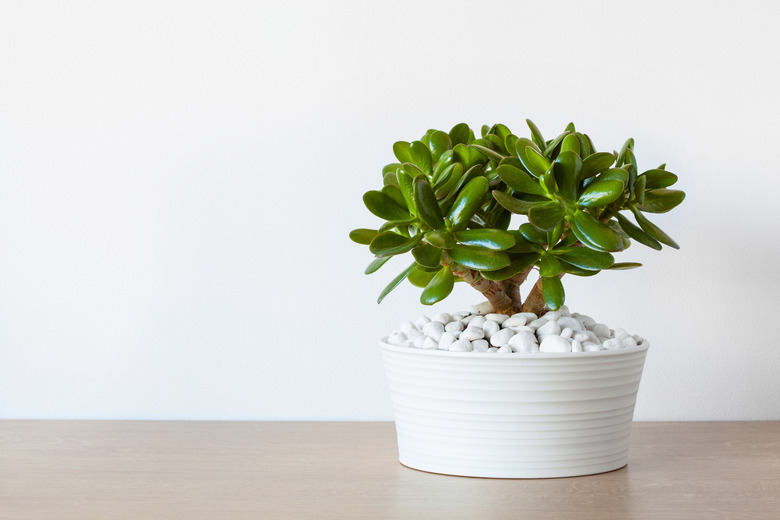How To Fertilize A Jade Plant
Jade plant (Crassula ovata, formerly C. argentea) is a super-easy plant to grow, especially for the forgetful gardener who prefers low-maintenance plants. Although jade grows as a perennial in the warm climates of U.S. Department of Agriculture plant hardiness zones 11 and 12, it's a popular houseplant in all zones. Two of the main reasons that it excels as a houseplant are that it thrives in containers and prospers in warm, dry interior environments, which are conditions that cause many houseplants to struggle.
As a succulent plant, jade has only a moderate demand for water during the growing season and needs even less water during fall and winter. It's important to allow the soil to dry slightly between waterings.
Tips on Fertilizing a Jade Plant
As part of its low-maintenance regimen, jade plant has a very low fertilization requirement. Many experts do not consider fertilizer necessary. However, if you wish to fertilize, apply a water-soluble houseplant fertilizer no more frequently than every three months. To prevent root injury, make sure the soil or potting mix is moist before applying fertilizer. And always follow label recommendations for mixing the fertilizer in water.
Due to the plant's minimal need for fertilizer, the choice of growing mix is important. Unlike other types of plants that flourish in organically rich, fertile potting mix, jade plant grows best when planted in a different medium.
Use a potting mix that's blended for succulents or cacti. These mixes contain ingredients that promote good drainage, including sand, pumice, and perlite. Avoid those that already contain fertilizer, because they may provide too much nutrition for a jade plant. The continual and slow release of nutrients, instead of a single fertilizer application every three months, may eventually burn plants.
Fertilizing a Repotted Jade Plant
Another of jade plant's desirable easy-care traits is that it will continue to grow for years while root-bound. Eventually, however, you'll need to repot your jade plant. As it ages, you may want to move it into a heavier pot because its top growth has a tendency to cause a lightweight pot to tip over. Or you may just want to repot your jade plant into a more ornamental container instead of the plastic utilitarian pot it came in.
Don't repot your jade plant until you see new foliage emerging, which signals onset of a growth period. Water the plant before removing it from its container and let the potting mix in the new container dry slightly after you repot it. A newly repotted jade needs to acclimate itself to its new surroundings before receiving fertilizer, so wait for at least four months after your jade plant has been repotted before applying fertilizer for the first time.
Other Jade Plant Cultural Requirements
Fertilizer is only one component of jade plant care. To keep your plant healthy, place it where it will receive bright light. A little direct sun, preferably in the mornings, is OK. But avoid giving it too much direct sun, particularly if you have one of the variegated cultivars such as C. ovata 'Tricolor' (green, cream, and pink leaves) or C. ovata 'Variegata' (green and cream leaves).
With no significant insect or disease problems, the primary challenge with growing jade plants is the potential rotting of roots and stems. This problem is caused by fungal pathogens that result from overwatering, or growing plants in a potting medium that doesn't drain well.
